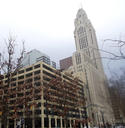The Covid-19 pandemic has brought about what Zillow calls “the great re-shuffling,” as more people head out of major metropolitan areas to work, often remotely, in less dense, even rural areas. read more »
Suburbs
Can We Save the Planet, Live Comfortably, and Have Children Too?
- Login to post comments
The Threat to Regional Unity
Happy New Year, everybody.
My latest column in Governing magazine is about another possible piece of fallout from the coronavirus, namely the undermining of the regional unity and solidarity that metropolitan areas have worked hard to build in recent years. Here’s an excerpt: read more »
- Login to post comments
California and Urban Cores Dominate Overcrowded Housing
Concern about overcrowded housing has been heightened by its association with greater COVID-19 infection risk. As a disease transmitted by human proximity, exposure is increased by being in overcrowded and insufficiently ventilated spaces where sufficient social distancing is not possible. Exposure density for a person is intensified by the amount of time spent in such circumstances. read more »
- Login to post comments
The Age of Suburbia
“Mr. Covid has been the best city and regional planner Australia has ever had. The suburbs will shine, and regions will grow. Maybe we should forget about big city infrastructure projects for a while and spend it on our future resilient communities where people look out for each other.” read more »
- Login to post comments
Post-Pandemic Housing Reality, Alt Cities to CA-NYC Housing Boom
A crazy week with a *ton* of new items I'll only be able to partially get through in this post, including some followups to last week's post about California tech companies moving to Texas: read more »
- Login to post comments
Latest Data Shows Pre-Pandemic Suburban/Exurban Population Gains
The latest complete American Community Survey (ACS) data, analyzed by the Demographia City Sector Model, indicates that population growth in the nation’s 53 major metropolitan areas (over 1,000,000 residents) continues to be, even before the pandemic, overwhelmingly suburban and exurban. read more »
- Login to post comments
NIMBYs Are Making More Noise Than Wind Turbines
There is increasing concern that electricity generation from fossil fuels contributes to climate change and air pollution. In response to these concerns, governments around the world are encouraging the installation of intermittent electricity generation projects including Industrial Wind Turbines (IWT’s). read more »
- Login to post comments
The Big Moves: Where People Are Moving
For decades, New York has been the leading exporter of people to other states, though has been severely challenged since 2000 by California. During five years around the housing bust, more net domestic migrants left California than New York. Then, for a time, California’s annual losses were not quite as severe read more »
- Login to post comments
Why Trump's America Will Live On
Like many, if not most Americans, I am somewhat relieved to see the petulant, nasty and sometimes clearly unhinged Donald Trump leave the White House. Yet for all his antics and vitriol, Trump has left a legacy that will be difficult to ignore and, given the dispensation of his opponents, could shape the future for the next decade. read more »
- Login to post comments
America Isn't Falling Apart. It's Still the Land of Opportunity
More than 840,000 green card holders became citizens last year, the most in a decade. Over 10 percent of the American electorate was born elsewhere, the highest share in a half-century. All of Donald Trump’s huffing and puffing could not stop this demographic evolution; nor could an endless stream of stories about what an unequal, unfair, and no good place America has supposedly become. read more »
- Login to post comments






















